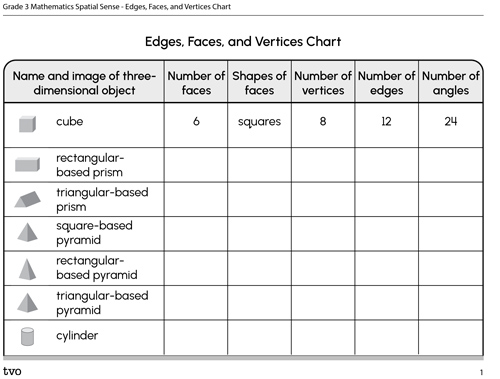Minds On
Exploring three-dimensional objects
A group of objects were sorted, but the sorting rule has gone missing.
Examine the following groups and determine the sorting rule for each group. What do the objects have in common? What is different about the objects in each group?

What might be a sorting rule for Group 1?
When you are ready, press ‘Sorting Rule’ to reveal a rule.
Group 1 sorting rule: objects with rectangular faces.

What might be a sorting rule for Group 2?
When you are ready, press ‘Sorting Rule’ to reveal a rule.
Group 2 sorting rule: objects that have corners (vertices).
What could be another sorting rule for Group 1 or Group 2?
Record your ideas in a notebook or a method of your choice.
Action
Reviewing two-dimensional shapes
In the Minds On section, we explored three-dimensional objects. You may have noticed that each three-dimensional object contains faces of two-dimensional shapes. Let’s do a quick review of two-dimensional shapes.
Know your shapes
For each shape, consider the following questions. Then select the correct description.
- What is a two-dimensional shape?
- How many straight sides does each shape have?
- How many corners does each shape have?
- Which sides have equal lengths?
- How many angles are the same? How do you know?
Identifying three-dimensional objects
To identify and compare three-dimensional objects, we can count their faces, edges, and vertices.
Faces
Faces are the two-dimensional flat surfaces that make up three-dimensional objects. Faces are never curved, but always flat.
For example, a cube has six square-shaped faces.

Test Your Skills!
Pick an object to explore
When classifying three-dimensional objects, it is useful to know:
- the names (shapes) of the faces
- the number of faces
Explore a three-dimensional object in your surroundings or online, and record the shapes of the faces.
Edges
Edges are where two faces meet on a three-dimensional object.
For example, a rectangle-based prism has twelve edges. The edges are where the rectangle faces meet.

Test Your Skills!
Pick an object to explore
When comparing three-dimensional objects, it is useful to know:
- the number of edges
Explore a three-dimensional object in your surroundings or online, and count the number of edges.
Vertices
Vertices are where two or more lines or edges meet. Vertices are the corners of three-dimensional objects.
The singular of “vertices” is vertex. A cone has one vertex.

When classifying three-dimensional objects, it is useful to know the number of vertices.
Angles and vertices
When edges meet at vertices, they make different angles.
We can count the number of angles in a three-dimensional object.
Putting it all together
Explore the three-dimensional objects in the following chart. For each object, record:
- the number of edges, faces, and vertices
- any two-dimensional shapes you recognize
The first one, a cube, has been done for you!
You can use the fillable and printable Edges, Faces, and Vertices Chart to complete this activity. If you prefer, you can also complete this activity in your notebook or use another method of your choice.
DescriptionA chart with 6 columns. The first column names three-dimensional objects. The second column is number of faces. The third column is shape of faces. The fourth column is number of vertices. The fifth column is number of edges. The sixth column is number of angles. The first three dimensional object is a cube. It has 6 faces. The shape of the faces is a square. The number of vertices is 8. The number of edges is 12. The number of angles is 24. The other three-dimensional objects to record are rectangular-based prism, triangular-based prism, square-based pyramid, rectangular-based pyramid, triangular-based pyramid and cylinder.

Press the Activity button to access Edges, Faces, and Vertices Chart.
Activity (Open PDF in a new tab)When you are ready, press ‘Answers’ to reveal the solutions for this activity.
 Description
Description
Cube has 6 square faces, 8 vertices, 12 edges and 24 angles. Rectangular-based prism has 6 rectangular faces, 8 vertices, 12 edges, and 24 angles. Triangular-based prism has 5 faces that are rectangles and triangles, 6 vertices, 9 edges and 18 angles. Square-based pyramid has 5 faces that are squares and triangles, 5 vertices, 8 edges and 16 angles. Rectangular-based pyramid has 5 faces that are rectangles and triangles, 5 vertices, 8 edges and 16 angles. Triangular-based pyramid has 4 triangular faces, 4 vertices, 6 edges and 12 angles. Cylinder has 3 faces that are circles and a rectangle, 0 vertices, 2 edges and 0 angles.
Consider the following questions:
- Do you notice any patterns in the chart?
- What are some similarities and differences between the different three-dimensional objects?
- While examining the chart, someone said they discovered that the number of vertices is always greater than the number of faces. Are they correct?
Consolidation
Create your own sorting rule
Create your own sorting rule and sort the following three-dimensional objects on the frame.
You can sort your objects according to their attributes: vertices, faces, shapes, angles etc.
You may create more than one sorting rule.
Let’s explore a Frame together!
What was your sorting rule? Did you have more than one?
Think about your learning
How does knowing about faces, edges, and vertices help you compare three-dimensional objects?
Reflection
How do you feel about what you have learned in this activity? Which of the next four sentences best matches how you are feeling about your learning? Press the button that is beside this sentence.
I feel...
Now, record your ideas about your feelings using a voice recorder, speech-to-text, or writing tool.